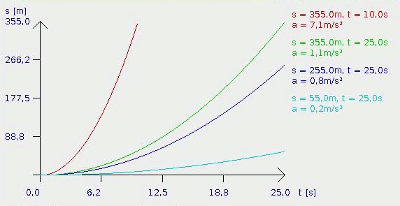|
|
|
|
News The Project Technology RoboSpatium Contribute Subject index Download Responses Games Gadgets Contact <<< Velocity Java-Applet acceleration >>> AccelerationTerminologyAcceleration is the change in velocity over time. The change in velocity is caused by a force and there is:
[2.2a] s - distance, t - time, v - velocity, f - force, m - mass, a - acceleration The above given correlations assume that the speeds are clearly smaller than the speed of light and the mass of the object is constant. The maximum speed of the fastest car on earth is 1227.98 km/h. Because light is traveling with 
Distance vs. time plotIf the force affecting an object is constant, the result of the plot is a parabola. The parabola's slope represents the velocity of the object.In practiceCar manufacturers declare the acceleration of their vehicles indirectly: They publish the time needed to accelerate from 0 to 100 km/h respectively from 0 to 60mph. By using formula (4b) you can calculate the average acceleration based on the given values.Besides the acceleration induced by throttle pedal, there are some more situations where acceleration operates. Braking means accelerating, too! The maximum acceleration values of a full brake application are consistently higher than during the speed-up. Even a compact car can stop within 50m from a speed of 100 km/h. Just a few roadsters can accelerate up to 100km/h within this distance. Even while the speedometer shows the same value, acceleration can occur. While driving through a turn, the travel direction and thus the velocity vector is altered. The passengers will realize this kind of acceleration by the counterforce, the centrifugal force. Besides this, every rough road accelerates a car in vertical direction. The following table lists some objects with their characteristic acceleration values:
From time specification 0-100km/h to the average accelerationThe conversion is based on formula (4b):v=100km/h according 100 / 3.6 m/s = 27.78m/s. Our compact car needs t=47s to speed-up. a = 27.78 / 47 m/s2 = 0.59 m/s2. From stopping distance 100-0km/h to the average accelerationInserting formula (4C) in formula (3a) results in:s=a/2 * (v/a)2 = a/2 * v2/a2 = v2/(2*a). Transforming leads to: a = v2/(2*s). Using the values of our compact car gives: a = 27.78 / (2 * 52.00) m/s2 = 7.41m/s2 The Java-application at the following page is about acceleration. Plotted are the correlations distance vs. time, speed vs. time and so on. In the 2D-simulation the acceleration of our compact car is compared to those of different "opponents". The opponents accelerate with their maximum value until they reach their maximum speed and than continue to drive with this speed. Your own car doesn't know a speed limit and accelerates until the simulation ends. Why this can not happen in reality will be explained at the following chapters. Play around with the physics of constant acceleration. <<< Velocity Java-Applet acceleration >>> News The Project Technology RoboSpatium Contribute Subject index Archives Download Responses Games Links Gadgets Contact Imprint |
|
|